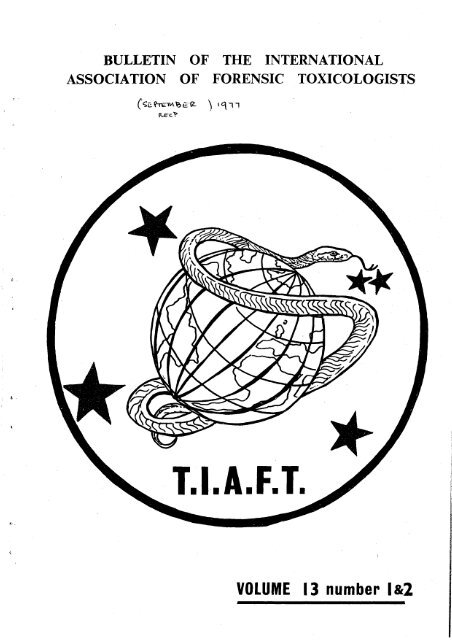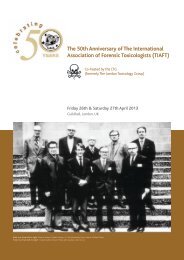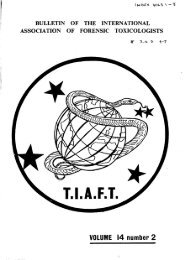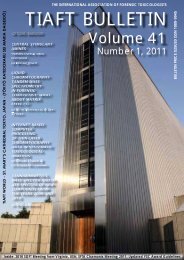Volume XIII Number 1&2.pdf - The International Association of ...
Volume XIII Number 1&2.pdf - The International Association of ...
Volume XIII Number 1&2.pdf - The International Association of ...
Create successful ePaper yourself
Turn your PDF publications into a flip-book with our unique Google optimized e-Paper software.
PRESIDENT'S MESSAGE<br />
- 2 -<br />
Pr<strong>of</strong>iciency Testing in Forensic Toxicology<br />
As a result <strong>of</strong> the expanding nature <strong>of</strong> toxicology and<br />
its many developing subspecialities-in the United<br />
States, a variety <strong>of</strong> legislation intended to regulate<br />
the standards <strong>of</strong> practice in toxicology laboratories<br />
has been promulgated. It is now highly likely that in<br />
the United States mandatory programs for Pr<strong>of</strong>iciency<br />
Tesing in analytical forensic toxicology will be enforaed<br />
within the very near future. It is my belief<br />
that our Forensic speciality and analytical toxicology<br />
methods applied to medico-legal investigation requires<br />
special consideration and the parameters for evaluating<br />
pr<strong>of</strong>iciency standards must be very carefully selected.<br />
It is with these considerations in mind that I and my<br />
fellow toxicologists at the Center For Human Toxicology<br />
<strong>of</strong>fer the following comments:<br />
$
- 11 -<br />
<strong>The</strong> recipient <strong>of</strong> many pr<strong>of</strong>essional honors and awards, some <strong>of</strong> his current activities<br />
include Criminalist, Oklahoma Department <strong>of</strong> Public Safety and Oklahoma State Bureau <strong>of</strong><br />
Investigation; Consultant, Center for Disease Control a!1d National Bureau <strong>of</strong> Standards; Member,<br />
Toxicology Resource Committee, College <strong>of</strong> American Pathologists; Past Chairman, Committee on<br />
Alcohol and Drugs, National Safety Council. Since 1970 he has also served as State Director <strong>of</strong><br />
Chemical Tests for Alcoholic Influence, State <strong>of</strong> Oklahoma.<br />
Dr. Dubowski served as Expert Consultant to the Executive Office <strong>of</strong> the President <strong>of</strong> the<br />
United States from 1973 to 1975 and is a former Consultant to the National Highway Traffic<br />
Safety Administration, U. S. Department <strong>of</strong> Transportation; Food and Drug Administration, National<br />
Institutes <strong>of</strong> Health, and National Institute on Alcohol Abuse and Alcoholism <strong>of</strong> the Department <strong>of</strong><br />
HEW.<br />
Established in 1948, the American Academy <strong>of</strong> Forensic Sciences consists <strong>of</strong> nine Sections<br />
including Criminalistics, Jurisprudence, Odontology, Pathology/Biology, Physical Anthropology,<br />
Psychiatry, Questioned Documents, Toxicology and a General Section which study and practice the<br />
interdisciplinary development and application <strong>of</strong> scientific evidence to the processes <strong>of</strong> law.<br />
Dr. Dubowski will succeed to the presidency <strong>of</strong> the Academy at the close <strong>of</strong> its 30th<br />
Annual Meeting which will be held at the Chase-Park Plaza Hotel, St. Louis, February 21-24, 1978.
CHANGES OF ADDRESS<br />
DR RAYMOND J BATH<br />
ALLIED CHENICAL<br />
POBOX l021R<br />
MORRISTOWN NJ 07960<br />
U.S.A.<br />
GEORGE DIMOPOULOS ESQ<br />
AGIOU MELETIOU 13 TT802<br />
KYPSELI<br />
ATHENS<br />
GREECE<br />
DR C REVES<br />
21 SILVER ASPEN CRESCENT<br />
OTTAWA ONTARIO<br />
CANADA<br />
KIB 3C3<br />
ARTHUR HOWARD ESQ<br />
CLINICAL RESEARCH CENTRE<br />
DIV. OF RHEUMATOLOGY<br />
WATFORD ROAD<br />
HARROW<br />
MIDDLESEX HAl 3UJ U.K.<br />
JAMES R HOWENSTINE ESQ<br />
2206 KUERBITZ DRIVE<br />
LANSING MICHIGAN 48906<br />
U.S.A.<br />
H. JUDD ESQ<br />
47 DOWNAGE<br />
LONDON N.W.4<br />
U.K.<br />
JOSEPH E KOLES ESQ<br />
6413 GATEWAY BLVD<br />
DISTRICT HEIGHTS<br />
MARYLAND 20028<br />
U.S.A.<br />
- 19 -<br />
SHARON K LYNCH<br />
LARAMIE COUNTY SHERIFF'S OFFIC E<br />
POST OFFICE BOX 787<br />
CHEYENNE WYOMING 82001<br />
U.S.A.<br />
MRS BETTY J PEACOCK<br />
FeDeLE SANFORD REG. CRIME LAB<br />
P.O. DRAWER 1737<br />
1211 26thPLACE<br />
SANFORD FLA 32771<br />
U.S.A.<br />
ELLIOTT SIMPSON ESQ<br />
CLINICAL BIOCHEMISTRY DEPT<br />
MONKLANDS DIST. GENERAL HOSPITlL<br />
MONKS COURT AVENUE<br />
AIRDRIE LANARKSHIRE ML6 OJS<br />
U.K ..<br />
DR HUGH T SMART<br />
3040 WILLOW STREET<br />
VANCOUVER<br />
B.C. CANADA<br />
V5Z 3P3<br />
NANCY SNELL<br />
TOXICOLOGY CLINICAL LABS A7-177<br />
CENTRE FOR THE HEALTH SCIENCES<br />
UCLA HOSPITAL & CLINICS<br />
LOS ANGELES CA 90024<br />
U.S.A.<br />
BETTY ANN WALKER<br />
STATE CRIME LABORATORY<br />
P.O. BOX 1644<br />
. MOULTRIE GA 31768<br />
U.S.A ..
- 22 -<br />
dissolved in ethanol. Qualification by TLC'; GLC and GC/MS and quantification<br />
by GLC were performed.<br />
,TI&. Kieselgel G, solvent methanol: ammonia ( 100 : 1.5), spray<br />
acidic iQdoplatinate, Rf 0.7 for lidocaine.<br />
GLC. Varian 140g, AFid, 3% OV-IZ 1.8 m column, T injector 250°C,<br />
column 220C, detector 250 C, carrier gas N2 37 ml/min, ret.t.<br />
0.15 relative to codeine for lidocaine.<br />
GC/MS. Varien Kat<br />
above: Mle<br />
86<br />
Quan ti fic a tion.<br />
234<br />
Blood<br />
Urine<br />
Brain<br />
Heart muscle<br />
Kidney<br />
Liver<br />
Spleen<br />
111, ionization energy 80 eV, GLC conditions as<br />
Corresp groups<br />
CH2N(CzH 5 )z<br />
C14H2ZNzO = M<br />
Case 1.<br />
33 ppm<br />
10 "<br />
21 n<br />
57 n<br />
56 "<br />
23 "<br />
53 ft<br />
Rel abund<br />
100<br />
O.Z<br />
Case 2.<br />
6 ppm<br />
3 "<br />
4. PROCYCLIDINE DEATH - Michael Liddy and Irene Glettig, Forensic Tox.<br />
Section, Div. <strong>of</strong> Analytical Labs. Health Commission <strong>of</strong> N.S.W.<br />
Lidcombe, N.S.W. 2141 Australia.<br />
Case History<br />
.§.!!.: Female Age: 53<br />
Poison Involved: Procyclidine<br />
Time <strong>of</strong> interval between intake and death: Not known (max 1 day)<br />
<strong>The</strong> deceased was found unconscious and died a few minutes later. <strong>The</strong><br />
deceased had been treated for numerous complaints and nervous condition<br />
for several years.<br />
Method <strong>of</strong> extraction:<br />
Tissues were extracted from alkaline, then acid solutions with<br />
chlor<strong>of</strong>orm.<br />
Method <strong>of</strong> identification:<br />
OV-l )5% on Chromo sorb W.5ft col), Oven Temp: 250 0<br />
Retention Index = 2230<br />
QF-l (4%, 5ft column) Oven Temp: 190 0<br />
Retention Index = 2436<br />
Method <strong>of</strong> quantitation:<br />
OT-17 (3% on Gas chrom Q. 3ft column)<br />
Oven temp: 220 0 C Retention index: 2490
References<br />
- 35 -<br />
(1) Davidow, B., Lipetri, N., and Quame, B<br />
A thin layer chromatographic screening technique for detection<br />
<strong>of</strong> drugs <strong>of</strong> abuse.<br />
Amer. J. <strong>of</strong> Clin. Path., 1968, 22, 714.<br />
(2) Clatworthy, A.J. Jones, L.V., and Whitehouse, M.J.<br />
<strong>The</strong> Gas Chromatography)Mass Spectrometry <strong>of</strong> the major metabolites<br />
<strong>of</strong> flurazepam.<br />
IN PRESS - Journal <strong>of</strong> Biomedical Mass Spectroscopy_<br />
15. FATAL TRICHLOROETHYLENE POISONING - G. Tadjer and M. Gampel, Dept.<br />
<strong>of</strong> Toxicology, and E. Daniels-Phillips, Dept. <strong>of</strong> Pathology, <strong>The</strong><br />
Institute <strong>of</strong> Forensic Medicine, Israel.<br />
Case History<br />
An adult male worker ag.ed 57 years was brought to the hospital<br />
at midnight and soon lapsed into coma. At his place <strong>of</strong> work a bottle<br />
<strong>of</strong> trichloroethylene was found and it was suspected that the patient<br />
had drank <strong>of</strong> it either intentionally or accidentally' ..<br />
Pathology"<br />
1.<br />
2.<br />
Lungs - heavy, congested and oedematous.<br />
Liver - enlarged with yellowish areas.<br />
Determination - Spectrophotometry<br />
A. Trichloroethylene was seperated by microdiffusion using the<br />
Conway unit (1) directly from blood, urine and homogenised tissues. <strong>The</strong><br />
Trichloroethylene passed into toluene and after. adding pyridin and NaOH<br />
sol. heated in the waterbath. <strong>The</strong> resulting .red colour was measured at<br />
530 nm (2).<br />
B. Trichloroacetic acid was extracted with ether (3) from<br />
blood, urine and homogenised tissues after the diffusing proc.edure. <strong>The</strong><br />
ether extract was evaporated, then heated with KOH sol. in boiling waterbath.<br />
pyridin was added, again heated, and the resulting red colour immediately<br />
read on Spectrophometer at 370 nm (3)<br />
Results <strong>of</strong> Analysis<br />
Urine from 13.5.76<br />
Urine from 15.5.76<br />
Blood.<br />
Liver<br />
Brain<br />
Lungs<br />
Kidney<br />
Stomach contents<br />
References<br />
Trichloroethylene<br />
in mg %<br />
0.24<br />
3 .. 22<br />
0 .. 70<br />
2 .. 54<br />
0.23<br />
0.16<br />
1 .. 80<br />
2 .. 00<br />
Trichloroacetate<br />
in mg %<br />
0.02<br />
0.03<br />
0.01.<br />
0.50<br />
0.06<br />
0 .. 04<br />
0 .. 03<br />
0.02<br />
(I) Conway II E"Jo Microdiffusion Analysis and <strong>Volume</strong>tric Error.<br />
De Van Nostrand COe, 1950<br />
(2) Milton Feldstein and N .. C. Klendshoj. <strong>The</strong> Determination <strong>of</strong><br />
Volatile Substances by Microdiffusion Analysis. J. Foren. Seien.<br />
2, No 1, 1957 p 39 -57 ..<br />
(3) C.H. Thienes and TeJ. Halley, Clinical Toxicology, 4th edition<br />
p 405 - 406 1964.
-47 -<br />
Please submit details <strong>of</strong> unusual cases to J.V. Jackson, Metropolitan<br />
Police Laboratory, 109 Lambeth Road, LONDON. SEI 7JH U.K. in the<br />
following form.<br />
Sex: Age:<br />
Poison involved:<br />
Time <strong>of</strong> interval between intake and death:<br />
Method <strong>of</strong> extraction:<br />
Method <strong>of</strong> identification:<br />
Method <strong>of</strong> quantitation:<br />
Were recovery experiments done and has a correction factor for losses<br />
been applied in reporting results?- Yes/No. If "Yes" give details.<br />
Details <strong>of</strong> other drugs or poisons involved;<br />
Results <strong>of</strong> analyses on *ante/post mortem samples:<br />
(If ante mortem give time 1ntervalbetween intake and sample taking.)<br />
Significant postmortem findings:<br />
Submitted by:<br />
* delete as- required.
A BIBLIOGRAPHY OF GC AND GC-MS<br />
APPLICATIONS IN TOXICOLOGY: 1972-75<br />
BY<br />
* . *<br />
LADISLAV KOPJAK , THOMAS A. JENNISON ,<br />
AND R.K. MUELLER+<br />
*Center For Human Toxicology, Univers ity <strong>of</strong> Utah, SLC, Utah<br />
+Instituts f. Gerichtl. Medizin, Karl-Marx-University, Leipzig<br />
PUBLISHED: JUNE 1976<br />
1. AMERICAN ACADEMY OF FORENSIC SCIENCES. TOXICOLOGY BULLETIN<br />
2. INTERNATIONAL ASSOCIATION OF FORENSIC TOXICOLOGISTS BULLETIN<br />
WORK SUPPORTED BY: FINNIGAN CORPORATION, SUNNYVALE, CALIFORNIA







